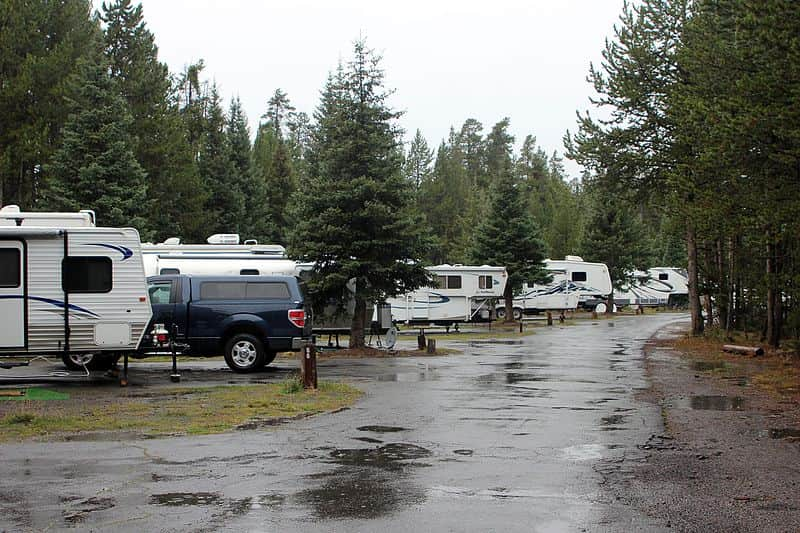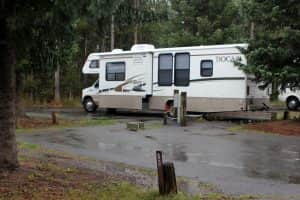Sizing RV-Park Electrical Services Using NEC Table
Published on October 5, 2018 by Jerry Durham

The Electrical Service supplying an entire RV park must be sized to accommodate the electrical demands of multiple modern recreational vehicles drawing power simultaneously from the individual park sites. The sum of the individual sites within the park, with some additional math applied, determines the total service size for the park.
Per the 2017 NEC, when calculating an RV park service, the load that you count for a single RV site equipped with a 125/250 volt, 50-ampere receptacle has been increased from 9600 volt-amperes to 12,000 volt-amperes.
The load you count for a single RV site equipped with both 30-ampere and 20-ampere receptacles remains unchanged at 3600 volt-amperes. The load counted for a 20-ampere RV site receptacle is 2400 volt-amperes. And the load counted for each 20-amp supply provided at each dedicated tent site is 600 volt-amperes.

The individual RV sites within an RV park are equipped with "supply-equipment" so that the RVs can connect to the available electric. These individual supply enclosures typically consist of more than one receptacle. When a multi-receptacle supply enclosure is dedicated to just a single RV, the load that you count toward determining the size of the entire park service is based on the single highest rated receptacle within that multi-receptacle enclosure. For example, if it contains a 50-ampere as well as a 20-ampere receptacle, you would only count the 50-ampere. However, where the supply enclosure is expected to serve two recreational vehicles, the load you count toward sizing the park service is calculated using the two highest rated receptacles within that enclosure and not just the one.

After adding up the individual sites throughout the park, the next step is to apply the demand factors found in Table 551.73(A). This Table allows for the derating of the park's service amps based on the total number of individual sites within the park. For example: The demand factor for a service supplying just 1 RV site is 100%, which is just another way of saying that there is no allowable demand factor at all. But when there are 36 or more sites in the park, the demand factor from the Table is 41%, regardless of how many sites there are beyond 36. This means the park electrical service can be sized at an ampacity no greater than what is necessary to adequately supply just 41% of the total load of 36 RV sites, instead of 100% for all 36 sites. This derating is permitted because the NEC assumes that all 36 sites won't be occupied and in full use at the same time. Note: The derated demand factors found in this Table are not applied to loads such as RV park bathrooms, recreational buildings, swimming pools, or similar amenities. These loads are calculated separately.
Here is an RV Park Service Calculation Example:
20 sites, and each site is equipped with:
One 50-ampere, 125/250-volt receptacle.
One 30-ampere, 125 volt receptacle.
One 20-ampere, 125 volt receptacle.
You just count the largest receptacle of the three, which is 50-ampere: (20 sites x 50 amp receptacles, worth 12,000 va each: 20 x 12,000 = 240,000 VA)
----------------------------------------
15 sites, and each site is equipped with:
One 30-ampere, 125 volt receptacle.
One 20-ampere, 125 volt receptacle.
Remember, when both 20-ampere and 30-ampere receptacles are present at one site, the value is 3600VA: (15 sites x 3600va = 54,000 VA)
--------------------------------------
15 sites, and each is equipped with:
One 20-ampere, 125 volt receptacle.
A 20-ampere receptacle is worth 2400va: (15 sites x 2400va = 36,000 VA)
----------------------------------------
10 sites for tent camping, each equipped with 20amps of power:
Each tent site supplied with 20 amps, counts as 600va: (10 sites x 600va = 6000 VA)
TOTAL VA FOR THESE 60 SITES = 336,000 VA
Demand Factor from Table 551.73(A) is 41 % for 36 or more RV sites, so 336,000 x 41% =137,760 VA
Finally: If the RV park's service is going to be 120/240 single phase, then the minimum ampacity for that service would be determined by taking that 137,760 VA and dividing by 240 V = 574 AMPS
A 600 Amp service would be adequate.
